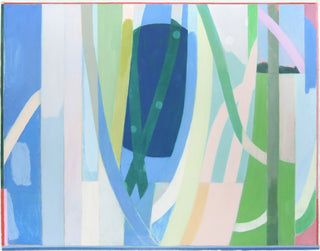Keri Kimura explores color through layered paintings that shift between landscape and abstraction to explore memory and the subconscious. She studied painting at Smith College, the Glasgow School of Art, and the New York Studio School. Kimura lives and works in Southwest Harbor, Maine.
Show Title: New Windows
Artist Statement: I’m a collector of colors and shapes, shadows, and patterns. I assemble them and weave them together, move them around, search for the places they resonate. I'm fascinated by pattern pieces. The kind you use to sew a shirt or pants, which is something my mother and grandmother both did. When you cut out the shape of a sleeve, it isn’t shaped like an arm. It has flat sides and gentle curves. But there’s a sense that it mimics the body, like a geometric shorthand. My paintings are a kind of shorthand too. Every painting begins with a collection of shapes, colors, patterns, ideas about a place, point in time, or problem. But I let them depart from that point. Sometimes I begin with collaged material, magazine scraps or pieces of old paintings. These become outlines. Every surface takes shape organically and sometimes comes to reference a landscape or physical space. At the same time, their ambiguity is important to me, because it keeps them in motion. I want the viewer to find their own space within the picture plane.




